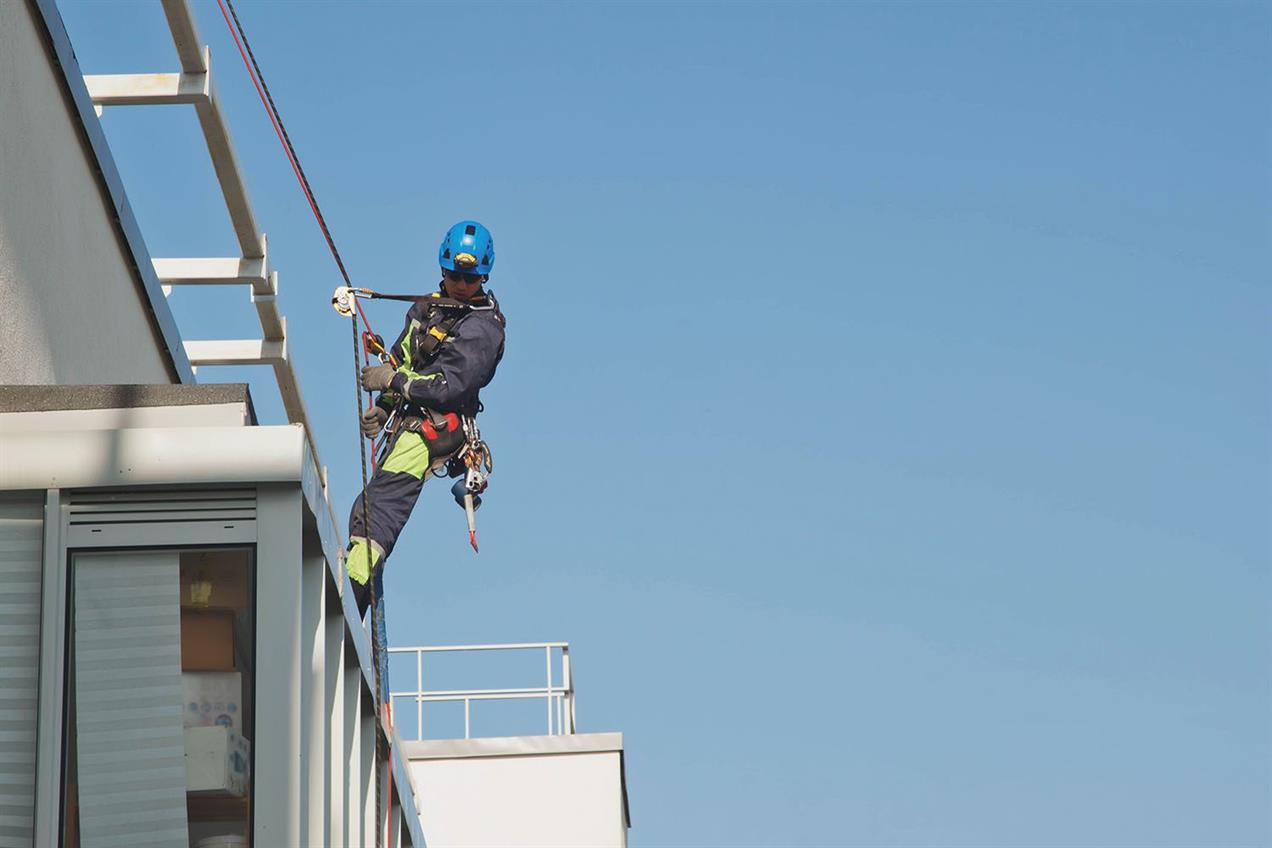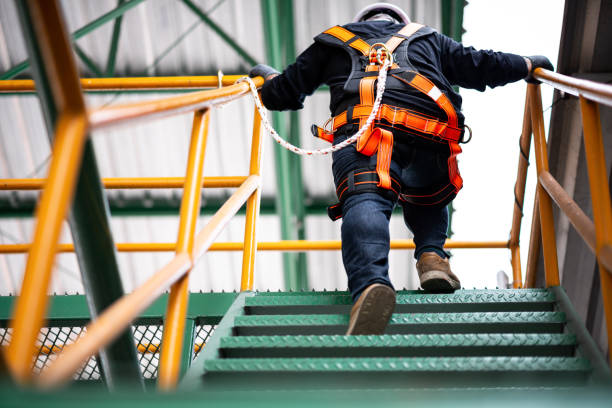Why Every Construction Site Needs A Reliable Fall Arrest System
Falls are one of the most common and dangerous risks faced by workers on construction sites. With activities often taking place at great heights, ensuring worker safety is not just important—it’s essential. A fall arrest system is a vital safety measure that prevents falls and minimises injuries, protecting both workers and businesses from serious consequences.
A fall arrest or restraint system works by stopping a fall in progress, using components such as harnesses, lanyards, and anchor points to secure workers and reduce the impact of a fall. These systems are a legal requirement on many sites, ensuring compliance with health and safety regulations in the UK. They are also a proactive step towards creating a safer and more productive workplace.
Without a reliable fall restraint system, construction sites face heightened risks, including injuries, project delays, and legal liabilities. These incidents can damage a company’s reputation and lead to significant financial costs. However, implementing an effective fall arrest system can prevent accidents, boost worker confidence, and ensure that construction projects run smoothly.
In this article, we at Elite Safety Solutions explore why every construction site should have a fall arrest or restraint system, the risks of operating without one, and how to choose the best system for your needs. With the right measures in place, you can protect your workforce and demonstrate a strong commitment to safety on every project.
What Is A Fall Arrest System And How Does It Work?
It is a safety solution designed to protect workers who operate at heights, preventing falls and reducing the risk of serious injury. These systems are critical on construction sites, where tasks like roofing, scaffolding, and working on steel structures expose workers to significant height-related hazards. Understanding how fall arrest or restraint systems work and their components can help businesses prioritise safety and compliance.
Key Components of a Fall Arrest System
A fall arrest or restraint system consists of several interconnected parts that work together to ensure safety. These include:
- Harnesses: Workers wear full-body harnesses, which are designed to distribute the force of a fall evenly across the body to minimise injury.
- Lanyards and Shock Absorbers: These connect the harness to the anchor point and reduce the force of impact during a fall by absorbing energy.
- Anchor Points: These are fixed, secure points on a structure where the system is attached. Anchor points must be capable of withstanding the forces generated during a fall.
- Lifelines: Horizontal or vertical lines that workers attach to for mobility while remaining secure.
How It Works
A fall arrest system activates when a worker falls, preventing them from hitting the ground. For example, the harness immediately arrests the fall while the lanyard’s shock absorber minimises the impact. The anchor point ensures the system remains stable, stopping the worker from falling further.
Types of Fall Arrest or Restraint Systems
There are two main types of fall arrest or restraint systems:
- Personal Fall Arrest Systems (PFAS): These protect individual workers and include a harness, lanyard, and anchor point.
- Collective Fall Arrest or Restraint Systems: These include safety nets designed to catch multiple workers in the event of a fall.
Why Fall Arrest or Restraint Systems Are Essential
These systems are not only life-saving but also mandatory under UK safety regulations. The Health and Safety Executive (HSE) requires fall protection for all workers at risk of falling from height, making fall arrest or restraint systems an important part of compliance.

The Risks Of Working Without A Fall Arrest System
Construction sites are among the most hazardous workplaces, with falls from height being one of the leading causes of injuries and fatalities. Operating without a fall arrest or restraint system significantly increases the risks for workers and businesses alike, leading to severe consequences that could have been avoided with proper safety measures in place.
1. Increased Risk of Accidents
Without a fall arrest system, workers exposed to unprotected edges, rooftops, or elevated platforms face a high likelihood of accidents. Slips, trips, and missteps are common on construction sites, and without fall protection, these incidents can result in catastrophic injuries or death. Even highly experienced workers are not immune to these risks, as unpredictable site conditions or sudden changes can lead to falls.
2. Legal and Financial Implications
Failing to use a fall arrest system not only endangers workers but also puts businesses at risk of legal action. In the UK, the Health and Safety Executive (HSE) requires employers to provide adequate fall protection for workers at height. Non-compliance can result in hefty fines, legal battles, and even site shutdowns. Beyond financial penalties, the reputational damage from failing to ensure worker safety can harm a company’s ability to secure future projects.
3. Impact on Productivity
Accidents on-site disrupt workflow and lead to project delays, especially when injuries require medical attention or investigations. A lack of a fall arrest system increases the likelihood of such disruptions, slowing progress and potentially causing projects to exceed budgets. Additionally, workers may feel anxious or hesitant without adequate safety measures, which can further hinder productivity.
4. Worker Morale and Retention
A workplace without proper safety systems sends a negative message to employees—that their well-being is not a priority. This can lead to dissatisfaction, lower morale, and difficulty retaining skilled workers. High staff turnover disrupts continuity and increases recruitment and training costs.
5. Preventable Tragedies
The absence of a fall arrest system often results in preventable accidents. A single investment in the right safety equipment can make the difference between life and death, offering protection that every worker deserves.
Working without a fall arrest or restraint system is a gamble no construction site should take. The risks far outweigh the cost of implementing safety measures, making fall arrest or restraint systems an essential investment for safeguarding workers, meeting legal requirements, and maintaining smooth operations.
Why Every Construction Site Should Have A Reliable Fall Restraint System
A fall arrest system is not just a legal requirement for construction sites—it is an essential tool for ensuring the safety and well-being of workers. These systems offer more than just compliance; they provide tangible benefits that improve site operations, enhance worker morale, and protect businesses from unforeseen risks.
1. Preventing Falls and Saving Lives
Falls from height are one of the leading causes of fatalities on construction sites. A reliable fall arrest system can mean the difference between life and death by stopping falls before they result in serious injury. By providing a dependable barrier of protection, these systems safeguard workers from the risks inherent in working at height, ensuring they can perform their duties without fear.
2. Compliance with Legal Standards
In the UK, the Health and Safety Executive (HSE) mandates the use of fall protection for all workers exposed to height-related risks. A fall arrest system ensures construction sites meet these regulatory requirements, avoiding fines and legal action. More importantly, compliance demonstrates a company’s commitment to worker safety, building trust with employees and clients alike.
3. Boosting Productivity and Efficiency
When workers feel secure, they are more focused and productive. A reliable fall arrest system allows employees to work with confidence, knowing they are protected from potential hazards. This translates to better efficiency on-site, as workers can concentrate on their tasks without unnecessary distractions or fear of accidents.
4. Reducing Financial Liabilities
Accidents can lead to substantial financial losses, including medical expenses, legal fees, increased insurance premiums, and project delays. Investing in a fall arrest system is a proactive step that minimises these risks, protecting both workers and the company’s bottom line. The cost of implementing a fall arrest or restraint system is far less than the potential expenses resulting from workplace accidents.
5. Improving Worker Morale and Retention
Workers are more likely to remain loyal to companies that prioritise their safety. Providing a safe working environment with a reliable fall arrest system demonstrates that a business values its employees. This can boost morale, reduce turnover, and attract skilled workers who are confident in the company’s commitment to safety.
6. Long-Term Cost Benefits
While the upfront cost of a fall arrest or restraint system may seem significant, the long-term savings from accident prevention, smoother operations, and improved worker productivity far outweigh the initial investment. Reliable safety measures are not just an expense—they are an investment in the company’s future success.
A reliable fall arrest or restraint system is an indispensable asset for every construction site. It protects workers, ensures compliance, and supports the efficient operation of projects, making it a must-have for any responsible construction business.

How To Choose The Right Fall Arrest System For Your Site
Selecting the right fall arrest or restraint system is important for ensuring worker safety and meeting legal requirements. With so many options available, it’s essential to consider key factors that match the specific needs of your construction site. This section outlines the steps and criteria to help you choose the most suitable system.
1. Assess Your Site’s Specific Needs
Every construction site is unique, with different layouts, height levels, and work tasks. Begin by evaluating your site’s conditions to determine what type of fall arrest system is required. For example, a site with multiple elevated platforms might benefit from horizontal lifelines, while vertical systems may be better suited for ladder work or confined spaces. Understanding the site’s risks ensures that the chosen system provides adequate protection.
2. Look for Certified Equipment
Ensure that the fall arrest system meets safety standards and is certified for use in the UK. Look for markings such as BS EN (British and European Standards) certifications, which indicate that the equipment has been rigorously tested for reliability and durability. Certified equipment not only ensures compliance but also gives peace of mind that the system will function correctly in an emergency.
3. Prioritise Worker Comfort
A system that is uncomfortable to use may discourage workers from using it correctly—or at all. Select harnesses that fit well and distribute weight evenly, reducing strain during prolonged use. Adjustable features are also beneficial, as they allow workers of different sizes to achieve a secure and comfortable fit.
4. Choose Durable Materials
Fall arrest systems must endure tough conditions, including weather exposure and heavy usage. Opt for equipment made from high-quality materials like stainless steel for anchor points and shock-resistant lanyards. Durable materials extend the lifespan of the system, ensuring that it remains reliable over time.
5. Consider Mobility and Freedom of Movement
Workers often need to move freely while remaining protected. Horizontal lifelines, for instance, allow workers to travel along an extended path without detaching from the system. Choosing a fall arrest system that balances safety with mobility ensures efficiency on-site.
6. Partner with a Reputable Supplier
Work with a trusted provider who specialises in fall protection solutions. A reputable supplier can guide you in selecting the best equipment for your needs, provide installation support, and offer ongoing maintenance services to keep the system in top condition.
7. Invest in Training and Maintenance
Even the best fall arrest system is ineffective if workers don’t know how to use it correctly. Provide training to ensure everyone understands how to attach, adjust, and inspect the equipment. Regular maintenance and inspections are equally important to ensure the system functions as intended.
Protect Your Workforce With A Reliable Fall Arrest System
Investing in a fall arrest or restraint system is one of the most important decisions a construction business can make. These systems save lives, prevent injuries, and create a safer, more productive work environment. By implementing the right fall arrest or restraint system, construction sites can effectively manage height-related risks, ensuring workers are protected while meeting legal requirements.
A reliable fall arrest system is more than just a safety measure—it’s a statement of commitment to your workforce. When workers know their safety is a priority, they feel valued, leading to improved morale, higher productivity, and greater job satisfaction. This not only benefits employees but also enhances the reputation of your company as a responsible and professional organisation.
Choosing the right system involves assessing your site’s specific needs, selecting certified and durable equipment, and providing adequate training for workers. Maintenance is equally crucial, as regular inspections ensure that the system remains effective over time. With the right approach, your fall arrest system becomes a long-term investment that pays off in safer operations and reduced liabilities.
At Elite Safety Solutions, we specialise in delivering high-quality fall arrest or restraint systems tailored to the needs of your site. Our team offers expert advice, certified equipment, and ongoing support to ensure your safety measures are always up to standard. Contact us today on 02393430067 to discuss your requirements and find the perfect fall arrest solution for your business.
Protect your team, comply with regulations, and build a stronger, safer workplace with a reliable fall arrest system. Let us help you make safety your priority.
